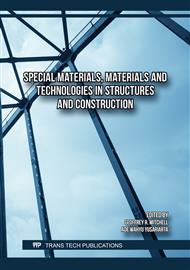[1]
United Nations Environment Programme, Single-use plastics, a roadmap for sustainability., n.d.
Google Scholar
[2]
T.R. Walker, L. Fequet, Current trends of unsustainable plastic production and micro(nano)plastic pollution, TrAC - Trends in Analytical Chemistry 160 (2023).
DOI: 10.1016/j.trac.2023.116984
Google Scholar
[3]
I. Almeshal, B.A. Tayeh, R. Alyousef, H. Alabduljabbar, A. Mustafa Mohamed, A. Alaskar, Use of recycled plastic as fine aggregate in cementitious composites: A review, Constr. Build Mater. 253 (2020).
DOI: 10.1016/j.conbuildmat.2020.119146
Google Scholar
[4]
M. Shams, I. Alam, M.S. Mahbub, Plastic Pollution During COVID-19: Plastic Waste Directives and Its Long-term Impact on The Environment, Environmental Advances 5 (2021).
DOI: 10.1016/j.envadv.2021.100119
Google Scholar
[5]
N. Parashar, S. Hait, Plastics in the time of COVID-19 pandemic: Protector or polluter?, Science of the Total Environment 759 (2021).
DOI: 10.1016/j.scitotenv.2020.144274
Google Scholar
[6]
N.U. Benson, D.E. Bassey, T. Palanisami, COVID pollution: impact of COVID-19 pandemic on global plastic waste footprint, Heliyon 7 (2021).
DOI: 10.1016/j.heliyon.2021.e06343
Google Scholar
[7]
Y. Liang, Q. Tan, Q. Song, J. Li, An analysis of the plastic waste trade and management in Asia, Waste Management 119 (2021) 242–253.
DOI: 10.1016/j.wasman.2020.09.049
Google Scholar
[8]
Kementerian Lingkungan Hidup dan Kehutanan Republik Indonesia, Capaian Kinerja Pengelolaan Sampah, Https://Sipsn.Menlhk.Go.Id/Sipsn/Public/Data/Capaian (n.d.).
Google Scholar
[9]
M. Belmokaddem, A. Mahi, Y. Senhadji, B.Y. Pekmezci, Mechanical and physical properties and morphology of concrete containing plastic waste as aggregate, Constr Build Mater 257 (2020).
DOI: 10.1016/j.conbuildmat.2020.119559
Google Scholar
[10]
A. Milbrandt, K. Coney, A. Badgett, G.T. Beckham, Quantification and evaluation of plastic waste in the United States, Resour Conserv Recycl 183 (2022).
DOI: 10.1016/j.resconrec.2022.106363
Google Scholar
[11]
X. Li, T.C. Ling, K. Hung Mo, Functions and impacts of plastic/rubber wastes as eco-friendly aggregate in concrete – A review, Constr Build Mater 240 (2020).
DOI: 10.1016/j.conbuildmat.2019.117869
Google Scholar
[12]
M. Anshassi, S.J. Laux, T.G. Townsend, Approaches to integrate sustainable materials management into waste management planning and policy, Resour Conserv Recycl 148 (2019) 55–66.
DOI: 10.1016/j.resconrec.2019.04.011
Google Scholar
[13]
E. del Rey Castillo, N. Almesfer, O. Saggi, J.M. Ingham, Light-weight concrete with artificial aggregate manufactured from plastic waste, Constr Build Mater 265 (2020).
DOI: 10.1016/j.conbuildmat.2020.120199
Google Scholar
[14]
A.A. Mohammed, I.I. Mohammed, S.A. Mohammed, Some properties of concrete with plastic aggregate derived from shredded PVC sheets, Constr Build Mater 201 (2019) 232–245.
DOI: 10.1016/j.conbuildmat.2018.12.145
Google Scholar
[15]
F.A. Spósito, R.T. Higuti, M.M. Tashima, J.L. Akasaki, J.L.P. Melges, C.C. Assunção, M. Bortoletto, R.G. Silva, C.F. Fioriti, Incorporation of PET wastes in rendering mortars based on Portland cement/hydrated lime, Journal of Building Engineering 32 (2020).
DOI: 10.1016/j.jobe.2020.101506
Google Scholar
[16]
H. Rajandas, S. Parimannan, K. Sathasivam, M. Ravichandran, L. Su Yin, A novel FTIR-ATR spectroscopy based technique for the estimation of low-density polyethylene biodegradation, Polym. Test. 31 (2012) 1094–1099.
DOI: 10.1016/j.polymertesting.2012.07.015
Google Scholar
[17]
J. V Gulmine, P.R. Janissek, H.M. Heise, L. Akcelrud, Test method Polyethylene characterization by FTIR, Polym. Test. 21 (2002) 557–563.
DOI: 10.1016/s0142-9418(01)00124-6
Google Scholar
[18]
V. Morgado, L. Gomes, R.J.N. Bettencourt da Silva, C. Palma, Validated spreadsheet for the identification of PE, PET, PP and PS microplastics by micro-ATR-FTIR spectra with known uncertainty, Talanta 234 (2021).
DOI: 10.1016/j.talanta.2021.122624
Google Scholar
[19]
M.J. Islam, M. Shahjalal, Effect of polypropylene plastic on concrete properties as a partial replacement of stone and brick aggregate, Case Studies in Construction Materials 15 (2021).
DOI: 10.1016/j.cscm.2021.e00627
Google Scholar


